Choosing the correct athletic footwear is crucial for optimizing performance and safety in sports.
Athletes often wonder: Can softball cleats be seamlessly used for soccer, and what are the fundamental distinctions between softball and soccer cleats?
Softball cleats and soccer cleats are designed with different sports demands in mind; thus, using softball cleats for soccer might not always be advisable. Soccer cleats are lighter, designed for agility and rapid direction changes on grass, whereas softball cleats are sturdier, with metal spikes for traction on dirt and grass, and may feature additional ankle support. Ideally, athletes should use sport-specific cleats for optimal performance and safety.
This consideration is grounded in both practicality and safety, as the detailed differences—from materials to cleat patterns—directly affect gameplay.
Deep diving into the characteristics, functionality, and design philosophy behind each type of cleat illustrates why choosing the right one is so crucial to an athlete’s performance on the field.
Key Takeaways
- Material and design differences between soccer and softball cleats cater to unique sport requirements, emphasizing the necessity of choosing according to specific needs.
- While selecting cleats, factors such as safety, performance influence, and sports regulations must be considered to ensure compliance and effectiveness.
Understanding the nuances of athletic footwear for soccer and softball not only guides your selection process but also promises a boost in your on-field endeavors, aligning with your performance goals and safety standards.
Can You Use Softball Cleats for Soccer? Analyzing the Pros and Cons
Venturing into the idea of repurposing softball cleats for soccer?
It’s critical to consider several factors, from safety implications to the influence on your performance, and the rules governing equipment use in soccer.
Safety Concerns
At first glance, the toe cleat on softball cleats seems like a minor difference.
However, specialized for gripping dirt fields, these cleats (those of other sports like Baseball or Gridiron football) can become a liability on the firmer grounds common in soccer.
The precise traction designed for soccer venues is absent, heightening the risk of slips and consequent injuries like twisted ankles.
Soccer cleats, tailored for these surfaces, significantly boost your safety, ensuring stable footing as you navigate the pitch.
Performance Impact
Diving deeper, the very essence of soccer cleats—light, agile, and low-cut—facilitates the quick, fluid movements quintessential to the sport.
In stark contrast, the added bulk and relative rigidity of softball cleats could be a drawback.
The weightiness might sap your speed, while the lack of adaptability may curb the quick footwork soccer demands, potentially putting a damper on your dynamism on the field.
Rules and Regulations
While navigating through the rules of soccer equipment, it’s pertinent to note that Law 4 – The Player’s Equipment of the IFAB (the independent guardians of the Laws of Football), specifically highlights the importance of donning attire that doesn’t pose risks, which includes choosing suitable footwear for gameplay.
Metal cleats—an occasional feature of softball footwear—are generally a no-go, ruled out because of the heightened injury risk they pose.
Compliance with league regulations is non-negotiable; failure to adhere can mean watching the game from the sidelines.
Always consult the specific guidelines of your soccer league or organization to confirm that your gear passes muster.
Before making the switch, it's essential to weigh these factors thoughtfully.
While it might seem convenient or cost-effective to repurpose softball cleats for soccer, doing so could inadvertently compromise your safety, hinder your performance, and even contravene the norms of the sport.
Core Differences Between Softball and Soccer Cleats
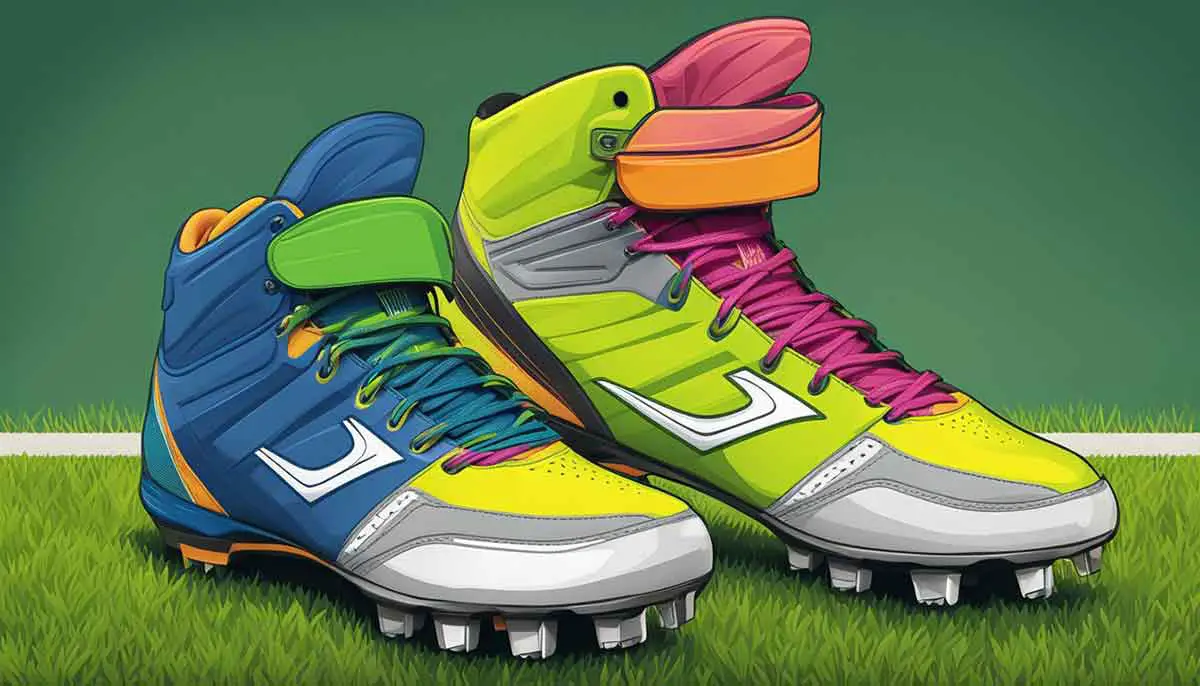
Understanding the unique characteristics of softball versus soccer cleats can significantly impact your performance on the field.
The distinct materials, patterns, and structural aspects set these two types of athletic footwear apart.
Material Composition
The choice of materials in softball and soccer cleats is driven by the distinct demands of each sport.
Soccer cleats prioritize lightweight materials, such as supple leather or advanced synthetics, enhancing ball control and facilitating swift movements.
Softball cleats often opt for more robust materials. They provide added durability and protection, critical for the sport's quick directional changes and sliding.
Cleat Pattern and Structure
The design and arrangement of the cleats—or studs—beneath each shoe are meticulously crafted to suit the specific needs of the sport.
Soccer cleats feature a consistent pattern of plastic or rubber studs. It’s ideal for grass fields, supporting explosive lateral movements without sacrificing speed.
Softball cleats may sport metal spikes. These spikes dig into dirt infields, offering unmatched grip and stability essential for dynamic plays.
Cleat Length
Cleat length is another aspect where soccer and softball footwear diverge.
Soccer cleats come with shorter studs—either plastic or rubber—to provide necessary traction while maintaining agility and speed.
For softball players, longer metal or molded cleats are common. These enhance the athlete's ability to anchor deeply into both dirt and grass, aiding in rapid accelerations and decelerations.
Overall Design and Functionality
The overall design of these cleats speaks directly to their intended function.
Soccer cleats sport a streamlined profile, emphasizing flexibility and comfort. It supports quick, agile movements and directional shifts.
Softball cleats have a slightly bulkier design. The additional heft offers greater ankle support and protection, which is paramount for the lateral movements, quick sprints, and stability required on the softball diamond.
Unpacking the Craftsmanship Behind Your Cleats
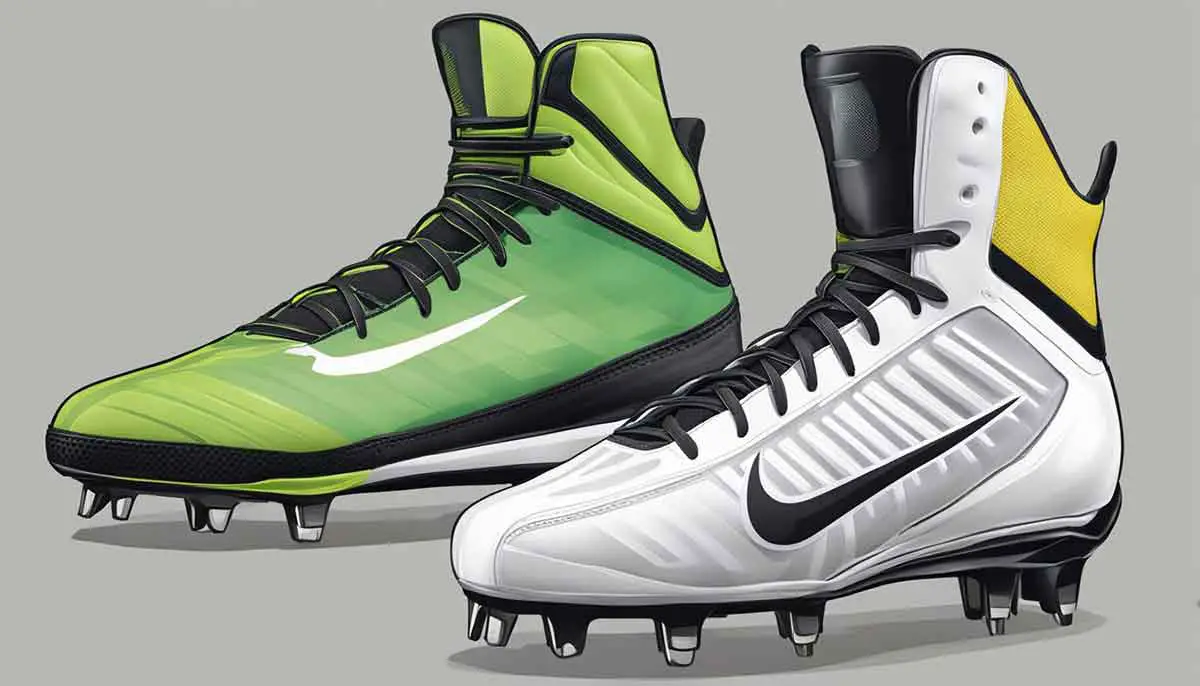
Stepping onto the field, the design and craftsmanship of your cleats aren't just accessories—they're your secret weapons.
In the world of soccer, the emphasis is on agility and speed.
This is why soccer cleats boast a lightweight design, enabling those lightning-fast sprints and agile cuts that define the game.
- Materials: Embracing state-of-the-art synthetic materials and synthetic leather, soccer cleats are the epitome of lightness, meant to fly rather than just run.
- Upper Construction: With an upper crafted from sleek synthetic leather or breathable mesh, often reinforced for a perfect fusion of support and agility, soccer cleats are designed to hug your feet like a second skin while allowing for maximum mobility.
Switch gears to softball cleats, and you'll find a fortress for your feet. Built to navigate quick pivots and lateral dashes with ease, they carry a bit more heft— a testament to their emphasis on stability and rugged traction.
- Materials: Leveraging sturdy leather or robust synthetic fabrications, softball cleats are the bulwarks of the infield, crafted for protection and enduring performance.
- Toe Cleat: A distinctive feature, the toe cleat on softball shoes, anchors you with unparalleled grip as you hustle from base to base, demonstrating how strategic design transforms physical performance.
The integrity of your cleats is paramount, with advancements around high-wear areas not only extending their life but also enhancing your play.
For soccer aficionados, the absence of toe cleats eliminates drag, marrying form with function to perfect your game.
And while the allure of synthetics for their feather-like weight is undeniable, the unrivaled touch and control offered by leather have a magic all its own.
Mastering Traction for Game-Changing Performance
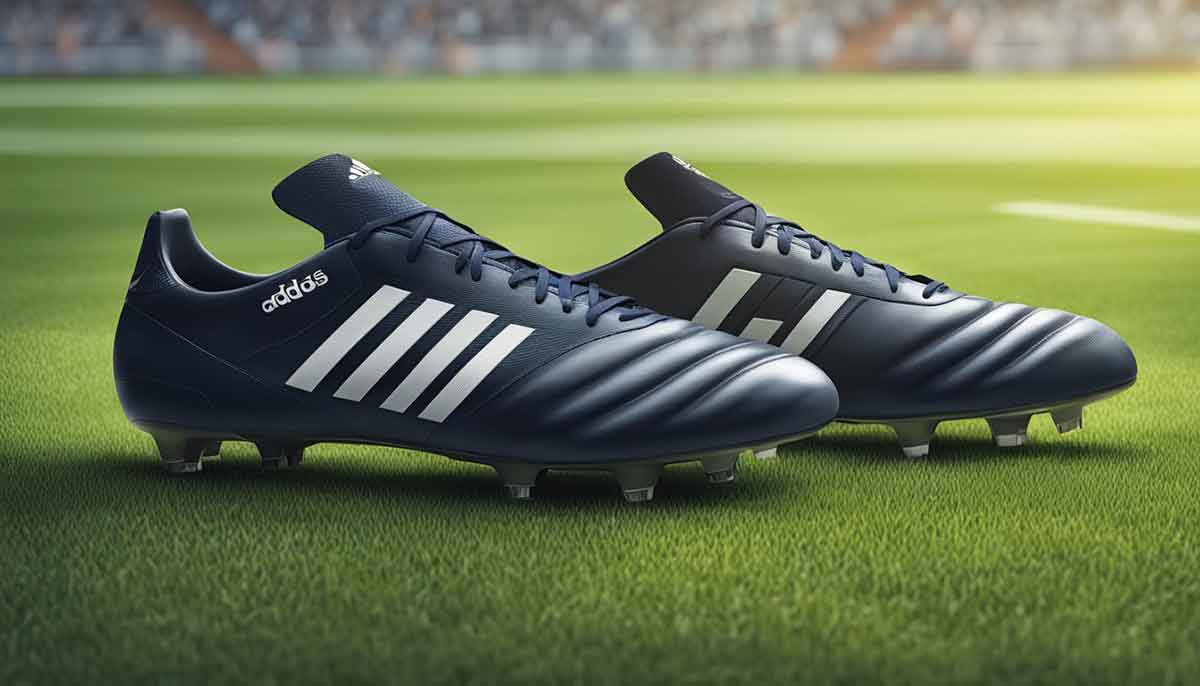
Picture this: you're dodging defenders with the elegance of a seasoned midfielder or racing to first base with the determination of a star slugger.
In these moments, traction isn't just useful; it's your unwavering ally in the quest for dominance.
Soccer cleats are your go-to for mastering the artful dance between agility and stability, sporting plastic studs that are tailor-made for nimble footwork and abrupt changes in direction.
Softball cleats, on the flip side, come equipped with a secret weapon—a toe stud. This little hero at the tip of your shoe is pivotal when igniting a dash from zero to hero.
Offering unparalleled grip and power, it empowers you with the explosive momentum needed for those game-changing starts, while its heft accentuates lateral stability and support, a true ally during dynamic movements.
- Soccer Cleats:
- Crafted for precision and poise.
- Feather-light to foster sprinting and swift pivots.
- Diverse stud configurations cater to various pitches, ensuring you're always at the top of your game.
- Softball Cleats:
- Boasting a toe cleat for majestic launches and unmatched traction.
- Metal studs cut deeper than plastic, gripping the earth with authority.
- Engineered for resilience against lateral shifts and sudden halts, these cleats are your fortress.
Choosing Cleats: The Intersection of Comfort and Fit
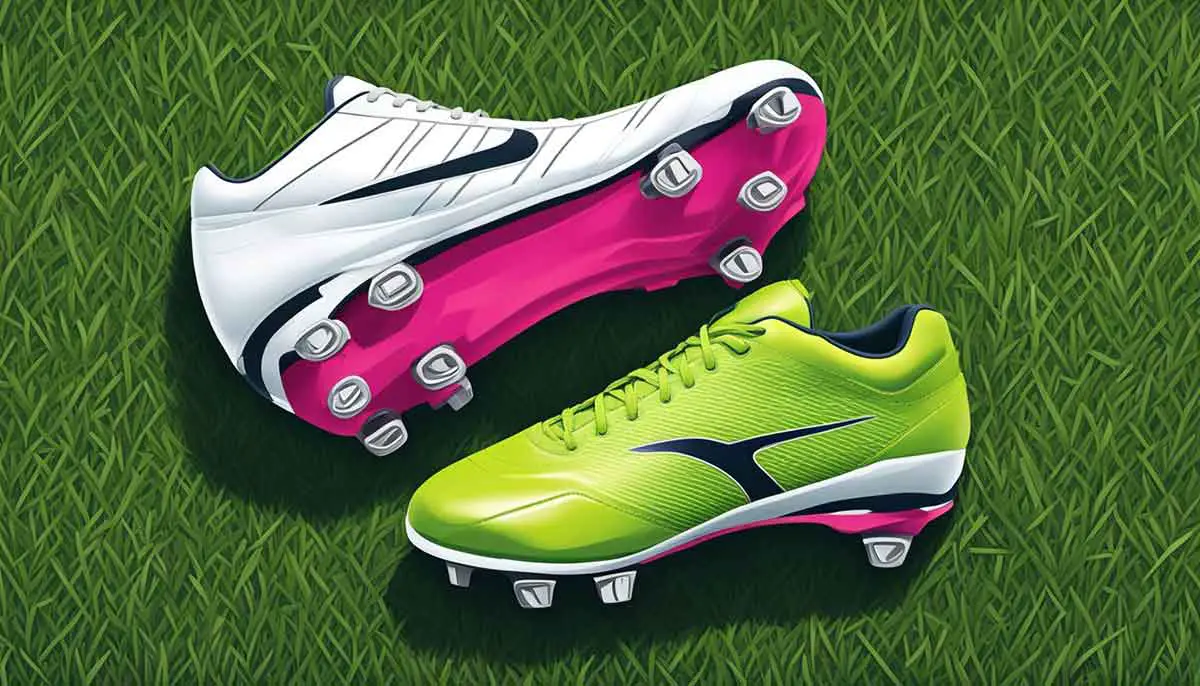
Selecting the perfect cleats isn't just a matter of style—comfort and fit are where the game is won or lost.
When it comes down to soccer and softball cleats, there's a balancing act between ensuring your feet can breathe and keeping them supported.
Soccer Cleats: Designed for the Dancer
Soccer cleats take a minimalistic approach to weight, offering a snug fit that feels like a second skin, designed to amplify your agility and acceleration.
Their low-cut silhouette may skimp on ankle support, but it excels in providing unparalleled flexibility and breathability.
This nimbleness is a gift during those extended sprints up and down the pitch.
Softball Cleats: The Sturdy Defender
Softball cleats are the guardians of your gait, crafted with enhanced cushioning and vital ankle support thanks to their often high-top design.
This protective embrace ensures your ankles remain supported during the sport's hallmark quick, lateral dashes.
While they may tip the scales a bit more, the trade-off is a fortified stability that some athletes find indispensable.
The Personal Touch
What works wonders for one athlete might not resonate with another.
Your mission is to find that perfect harmony between support and comfort that resonates with your gameplay. Here's a quick cheat sheet:
- Soccer cleats: Favor a lightweight, form-fitting design with a focus on flexibility and air flow.
- Softball cleats: Offer a snug fortress of cushioning and ankle support, albeit with a bit more heft.
Embark on your quest by slipping into various pairs and really feel them out—walk, jog, pivot.
The ideal cleat will meld to your foot, disappearing from your mind as you play, allowing you to concentrate solely on the glory of the game.
Forging Cleats to Last: Durability Meets Demand
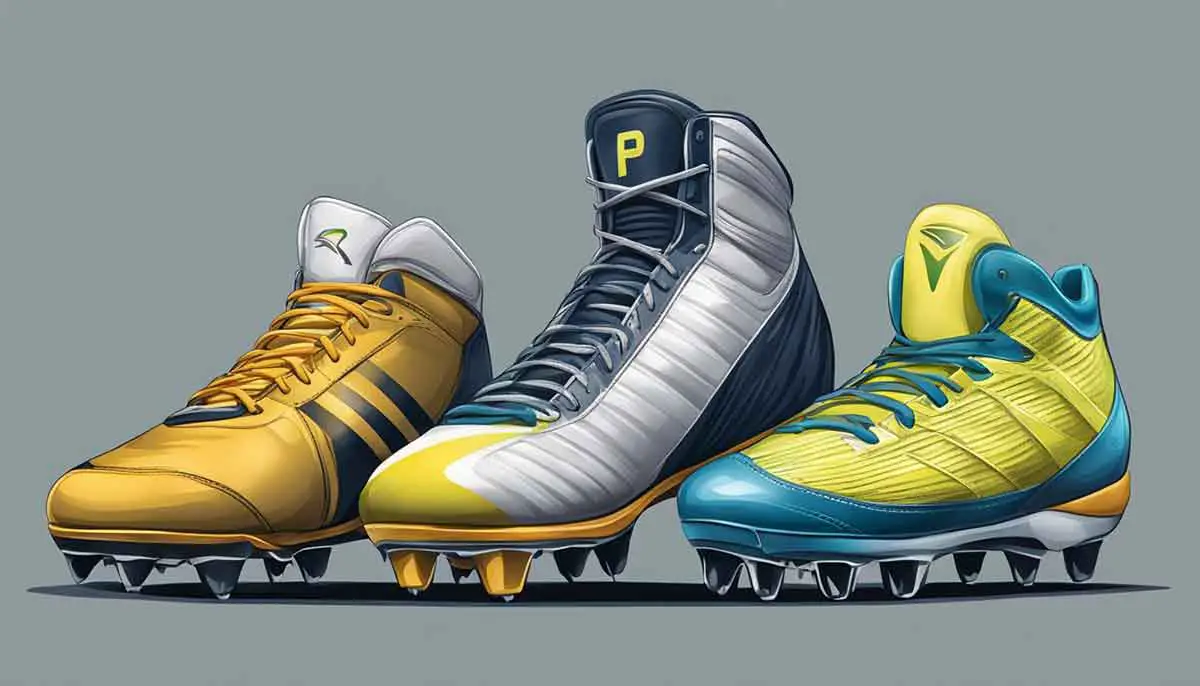
In the relentless pursuit of victory, your cleats are more than just footwear—they're the foundation of every play.
This is particularly true in soccer, where the dynamics of your game hinge on the durability of your cleats amidst rigorous runs, sudden stops, and intricate footwork.
Soccer cleats stand at the forefront, crafted from robust synthetics or the finest leathers, all while maintaining the essential lightweight silhouette that adds that critical zip to your step at moment's notice.
The Blueprint of Longevity: Construction
Beyond just raw materials, the artistry in construction plays a pivotal role in a cleat’s lifespan.
With precise stitching and strategically bolstered materials in areas prone to the most stress, soccer cleats are built not just to last, but to excel.
Although they may forego the extensive ankle support characteristic of softball cleats, this is a deliberate choice to prize agility and a close, responsive fit that curtails internal foot movement.
Ensuring Your Cleats Go the Distance
- Materials: Choose between the resilience of synthetic materials or the suppleness of leather for soccer; opt for the structured, protective designs of softball cleats.
- Wear and Tear Management: While soccer cleats marry durability with dexterity, softball cleats underscore comprehensive foot and ankle protection.
- Cleat Longevity: Although both varieties benefit immensely from meticulous care, soccer cleats might beckon for replacement more frequently, given their lighter build.
What ultimately defines the lifespan of your cleats isn't just the quality of their construction but how they sustain performance through the heat of competition and the rigors of practice.
Navigating Cost and Availability: The Cleats Edition
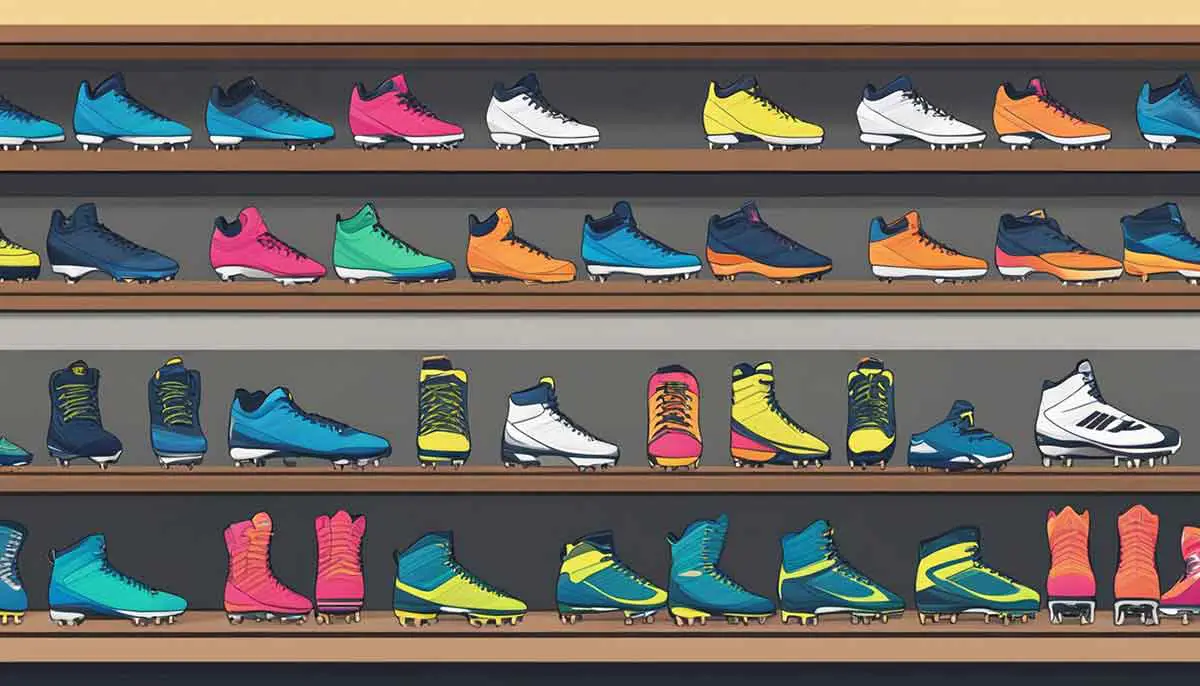
When it's time to gear up for an upcoming season, the journey begins with understanding the cost landscape and pinpointing where to find your next pair of game-changers.
Soccer and softball cleats each bear unique price points, influenced heavily by the cutting-edge technologies and specialized materials engineered for peak performance in each sport.
For soccer aficionados, the quest for feather-light agility translates to potentially higher costs due to the innovative materials in play.
Softball Cleats: Economically Friendly Field Warriors
- Priced with accessibility in mind, softball cleats typically span from $30 to $90.
- Available with metal studs for the serious competitor or plastic ones for versatility.
Soccer Cleats: Investing in High-Speed Precision
- Prepare to invest anywhere from $50 to upwards of $200 for top-tier, professional-grade models.
- The realm of soccer cleats leans towards plastic or rubber studs, designed for adaptability on various terrains.
As for availability, it ebbs and flows with the seasons and fluctuating demand.
Both soccer and softball cleats are staples at sporting goods outlets and online, with the richest selections unveiled in the lead-up to and throughout their respective peak seasons.
Given soccer's global appeal, it's no surprise that these cleats might boast a wider distribution network and a more diverse array of choices.
Where to Shop
- For Softball Enthusiasts: Venture into sporting goods stores, explore niche sporting outlets, or tap into online marketplaces for your perfect pair.
- For Soccer Players: Soccer specialty shops, major athletic retailers, and the official websites of leading brands are your go-to destinations.
Picking softball or soccer cleats is an informed decision based on your role in the game and how you play it.
Investing wisely means choosing gear that not only aligns with your budget but also serves your specific needs on the field, enhancing both performance and comfort.
Elevating Your Game: A Guide to Selecting Soccer Gear
When it comes to soccer, your cleats are a crucial element in your quest for superiority on the field.
Understanding their nuances and uniquenesses can significantly boost your performance, so let’s check them out.
Scoring the Perfect Cleats
The journey to finding the ideal soccer cleats starts with knowing where you'll be showcasing your skills.
The type of playing surface dictates the cleat configuration that will best support your game:
- Natural Grass Fields: Opt for firm ground (FG) cleats. Their traditional stud configurations—either conical for quick release or bladed for added traction—help keep you securely grounded without compromising mobility.
- Artificial Turf: Turf (TF) cleats are the go-to. Their shorter, denser studs cater to synthetic fibers, enhancing durability and providing that extra agility for tight maneuvers.
Key Considerations for Cleat Shopping
In the quest for your soulmate in cleats, consider fit, comfort, and material as your guiding stars:
- Material Choices: Leather promises a tender, responsive touch on the ball, molding to your foot over time for that bespoke fit. For warriors of the weather and rigorous play, synthetics offer resilience and a steadfast barrier against elements.
- Fit and Comfort: Aim for a snug embrace, one that prevents any slide inside (which could lead to blisters) but still respects your foot's need for freedom, ensuring you focus on ball control, not on foot discomfort.
Keeping Your Cleats in Champion Condition
Cleat longevity is not just about durability upon purchase—it's an ongoing commitment. Here are a few steps to safeguard your gear's condition and performance prowess:
- Post-Match Care: Adhere to a cool-down routine for your cleats; brush off the grime of victory and let them air dry in the open, away from the harshness of direct heat.
- Strategic Storage: Treat them to a serene resting place, cool and dry, which preserves their form and readiness for the next clash.
FAQ: Frequently Asked Questions
What are the main differences between softball cleats and soccer cleats?
Softball cleats are built sturdy to offer enhanced support and protection, particularly around the ankles, and tend to have a heavier construction. Soccer cleats champion a lighter, low-cut design, primed for enabling swift, agile movements and acceleration.
Are soccer cleats suitable for playing softball?
While you might manage with soccer cleats for casual softball outings, they lack the ankle protection and dirt surface traction provided by dedicated softball cleats. This shortfall could compromise both safety and performance on the diamond.
Can my child use their soccer cleats when playing softball?
Starting out or participating in non-competitive softball, soccer cleats may suffice. However, as play becomes more frequent and skills progress, opting for softball-specific cleats will significantly benefit their performance and safety.
Is it acceptable to wear softball cleats while playing soccer?
Due to the unique demands of soccer, including the need for rapid direction changes, soccer-specific cleats are advisable. Softball cleats may impede the ability to execute quick maneuvers and sprints effectively on the soccer field.
What should I consider when choosing between softball and soccer cleats for women?
Selecting cleats involves assessing the design, weight, and material to ensure they cater to the demands of the chosen sport. Ideally, women's cleats should snugly fit while offering the essential flexibility and stability for sport-specific movements.
For safety and performance, which cleats are recommended for youth softball?
Youth softball players should focus on cleats that promise solid traction, ample support, and durability. Footwear specifically designed for softball provides these vital features, boosting both safety and performance on the field.

